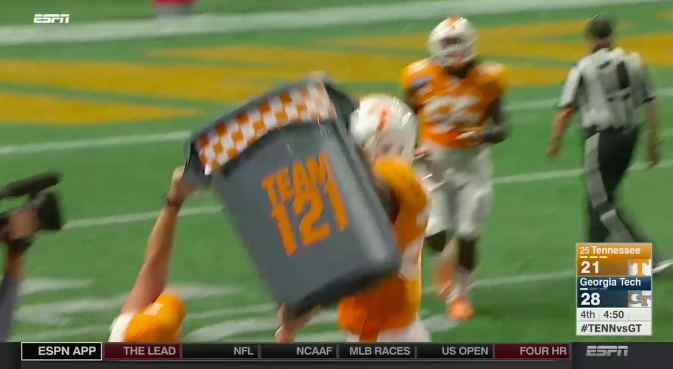College football’s opening weekend ended with a cross-conference showdown between Tennessee and Georgia Tech in the new Atlanta stadium with the Chick-fil-A. And maybe it’s the long weekend of five consecutive nights of football. Or maybe it was watching the clockwork, ball control offense of the Yellow Jacket triple option attack. But it seems like all that anyone could talk about was what in the world Tennessee was doing with that giant trash can on the sidelines.
Sideline props in college football have been the rage for a while now as programs look for any and every way to get college kids hyped. There was even one game (I can’t remember which one because I watched about 37 different ones this weekend) where a coach handed a player a professional wrestling championship belt once he got on the sidelines for making a play.
But a trash can? A trash can? Apparently it was a fixture on the Volunteers sideline when they were on defense.
When Tennessee is on defense, there is a trash can being held up on the sideline.
Do with that what you will. pic.twitter.com/6nhPJ1rIKo
— Barrett Sallee 🇺🇸 (@BarrettSallee) September 5, 2017
Sure enough, when Tennessee recovered a fumble late in the fourth quarter down by seven points and with Georgia Tech driving to put the game away, the Vols defender came over and dunked the football in the trash can. Well, at least he tried to dunk it in the trash can. The attempt hit the rim and bounced out.
The “Team 121” is in reference to how many years Tennessee football has been in existence and is a long-standing program tradition. The physical nature of the trash can appears to be some kind of motivational tactic that Butch Jones is using for his team. Like, the defense gets the ball from the offense and then… gets to take out the trash? Maybe it’s some sort of metaphorical statement about issues of waste management? Whatever it is, it sure got everyone’s attention… for better and for worse.
Tennessee's coaching staff had to agree to have a man hold a trash can up the entire game. Of all the props in the world, they picked that. pic.twitter.com/0lGw9Rz2LG
— Mark Harris (@itismarkharris) September 5, 2017
EXCLUSIVE look inside the trash can on Tennessee's sideline: #TENNvsGT pic.twitter.com/FdC2ZULyaS
— Jake Weaver (@JWeaverAL) September 5, 2017
Can ya'll imagine Saban's reaction when some low level assistant suggests carrying around a trash can on the sideline?
— Matt Stepp (@Matt_Stepp817) September 5, 2017
I like gimmicks in college sports. I do. But a trash can on the sideline to dunk in? pic.twitter.com/mtY4LN0xo1
— Aaron Suttles (@AaronSuttles) September 5, 2017
If you were a coach on the hot seat and your team frequently played like crap, would you put a trash can on the sideline?
— Clay Travis (@ClayTravis) September 5, 2017
Gonna be weird when three Tennessee players grab their coach and dunk him in that trash can.
— Gary Parrish (@GaryParrishCBS) September 5, 2017
Maybe having a player carry a trash can on the sidelines is a little too on the nose Butch
— ¡BUM CHILLUPS AKA SPENCER HALL! (@edsbs) September 5, 2017
The gimmick things like a Trash Can "turnover" dunk bucket…or whatever…are ridiculous…Focus on the details & effort it takes to win
— Joel Klatt (@joelklatt) September 5, 2017
https://twitter.com/MattSBN/status/904897720518930433
Tennessee and Georgia Tech are headed into overtime as of press time, but it’s clear the trash can won the night and clearly did the job to help the Volunteers to come back from a 14 point deficit. It’s the best clutch performance by a non-living object since the inanimate carbon rod.






